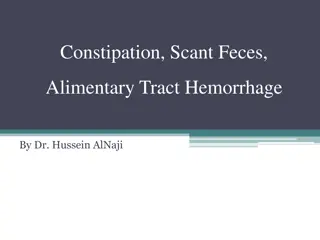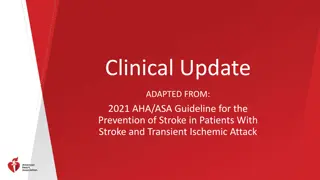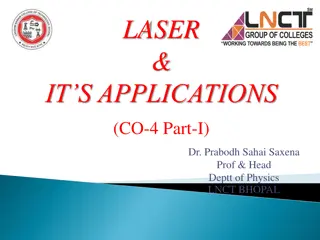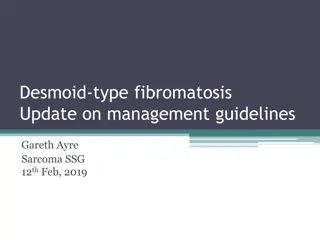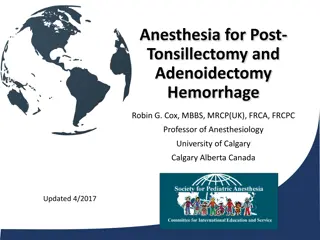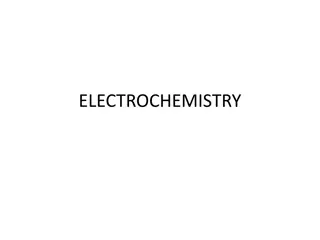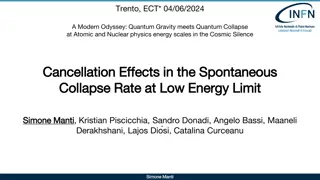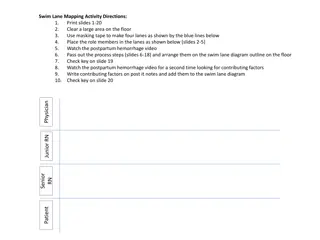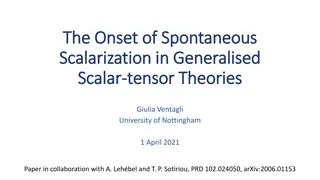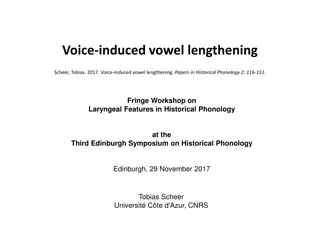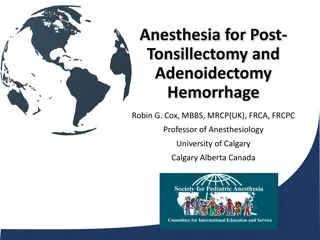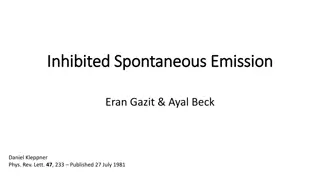Clinical Update on Management of Spontaneous Intracerebral Hemorrhage
This clinical update, adapted from the 2022 guideline by the American Heart Association and American Stroke Association, covers a comprehensive range of topics related to the management of patients with spontaneous intracerebral hemorrhage. It includes information on population health implications, surgical interventions, outcome prediction, rehabilitation, diagnosis, medical treatments, prevention strategies, and more. The guideline also provides a detailed classification of recommendation strength and the level of evidence supporting each recommendation.
- Clinical update
- Spontaneous intracerebral hemorrhage
- American Heart Association
- American Stroke Association
- Guideline
Download Presentation

Please find below an Image/Link to download the presentation.
The content on the website is provided AS IS for your information and personal use only. It may not be sold, licensed, or shared on other websites without obtaining consent from the author. Download presentation by click this link. If you encounter any issues during the download, it is possible that the publisher has removed the file from their server.
E N D
Presentation Transcript
AHA Clinical Update ADAPTED FROM: 2022 Guideline for the Management of Patients With Spontaneous Intracerebral Hemorrhage: A Guideline From the American Heart Association/ American Stroke Association
TABLE OF CONTENTS Population Health Implications Surgical Interventions Mechanisms of ICH Injury Outcome Prediction & Goals of Care ICH Etiology Determines Hemorrhage Location Decisions to Limit Life-Sustaining Treatment Rehabilitation & Recovery Diagnosis & Assessment Neurobehavioral Complications Medical and Neurointensive Tx for ICH Secondary Prevention Hemostasis & Coagulopathy Primary ICH Prevention in Individuals with High-Risk Imaging Findings General Inpatient Care Seizures & Antiseizure Drugs Neuroinvasive Monitoring, Intracranial Pressure & Edema Treatment 2
CLASS (STRENGTH) OF RECOMMENDATION LEVEL (QUALITY) OF EVIDENCE LEVEL A CLASS 1 (STRONG) Benefit >>> Risk High-quality evidence from more than 1 RCT Meta-analyses of high-quality RCTs One or more RCTs corroborated by high-quality registry studies Suggested phrases for writing recommendations: Is recommended Is indicated/useful/effective/beneficial Should be performed/administered/other Comparative-Effectiveness Phrases : Treatment/strategy A is recommended/indicated in preference to treatment B Treatment A should be chosen over treatment B LEVEL B-R (Randomized) Moderate-quality evidence from 1 or more RCTs Meta-analyses of moderate-quality RCTs Table 1. Applying Class of Recommendation and Level of Evidence to Clinical Strategies, Interventions, Treatments, or Diagnostic Testing in Patient Care LEVEL B-NR (Nonrandomized) CLASS 2a (MODERATE) Benefit >> Risk Moderate-quality evidence from 1 or more well-designed, well-executed nonrandomized studies, observational studies, or registry studies Meta-analyses of such studies Suggested phrases for writing recommendations: Is reasonable Can be useful/effective/beneficial Comparative-Effectiveness Phrases : Treatment/strategy A is probably recommended/indicated in preference to treatment B It is reasonable to choose treatment A over treatment B LEVEL C-LD (Limited Data) Randomized or nonrandomized observational or registry studies with limitations of design or execution Meta-analyses of such studies Physiological or mechanistic studies in human subjects CLASS 2b (Weak) Benefit Risk LEVEL C-EO (Expert Opinion) Suggested phrases for writing recommendations: May/might be reasonable May/might be considered Usefulness/effectiveness is unknown/unclear/uncertain or not well-established Consensus of expert opinion based on clinical experience. COR and LOE are determined independently (any COR may be paired with any LOE). A recommendation with LOE C does not imply that the recommendation is weak. Many important clinical questions addressed in guidelines do not lend themselves to clinical trials. Although RCTs are unavailable, there may be a very clear clinical consensus that a particular test or therapy is useful or effective. CLASS 3: No Benefit (MODERATE) Benefit = Risk Suggested phrases for writing recommendations: Is not recommended Is not indicated/useful/effective/beneficial Should not be performed/administered/other *The outcome or result of the intervention should be specified (an improved clinical outcome or increased diagnostic accuracy or incremental prognostic information). For comparative-effectiveness recommendation (COR 1 and 2a; LOE A and B only), studies that support the use of comparator verbs should involve direct comparisons of the treatments or strategies being evaluated. The method of assessing quality is evolving, including the application of standardized, widely- used, and preferably validated evidence grading tools; and for systematic reviews, the incorporation of an Evidence Review Committee. CLASS 3: Harm (STRONG) Risk > Benefit COR indicates Class of Recommendation; EO, expert opinion; LD, limited data; LOE, Level of Evidence; NR, nonrandomized; R, randomized; and RCT, randomized controlled trial. Suggested phrases for writing recommendations: Potentially harmful Causes harm Associated with excess morbidity/mortality 3 Greenberg, S. M. 2022 AHA/ASA . Guideline for the Management of Patients with Spontaneous Intracerebral Hemorrhage. Circulation. Should not be performed/administered/other
Population Health Implications Annual Ischemic Stroke & ICH Incidence SAH, 16K ICH, 79K Total Strokes: ~795K Incidence of ICH by Race 1.6-fold greater among Black than White people Early-term ICH Mortality is 30-40% Ischemic Strokes, 690K 1.6-fold greater among Mexican American than non-Hispanic White people Abbreviations: ICH indicates intracerebral hemorrhage; and SAH, subarachnoid hemorrhage. Greenberg, S. M. 2022 AHA/ASA . Guideline for the Management of Patients with Spontaneous Intracerebral Hemorrhage. Circulation.
Mechanisms of ICH Injury 0 - 6 hours >6 hours Primary Injury Secondary Injury ICP Cerebral Edema Hematoma Expansion Hydrocephalus Inflammation Herniation Toxicity from Blood Products General Principle: Acute ICH management targets these mechanisms. Abbreviations: ICH indicates intracerebral hemorrhage; and ICP, intracranial pressure. Greenberg, S. M. 2022 AHA/ASA . Guideline for the Management of Patients with Spontaneous Intracerebral Hemorrhage. Circulation. 5
ICH Etiology Determines Hemorrhage Location Deep/Posterior Fossa ICH Etiologies Lobar ICH Etiologies Cerebral Amyloid Angiopathy Amyloid deposition in vessel walls Arteriolosclerosis Penetrating arteriole lipohyalinosis due to HTN, DM, Age Arteriolosclerosis Macrovascular AVM Aneurysm Dural AVF Cavernous Malformation/Cavernoma Cerebral Venous Thrombosis Macrovascular Diagnostic Reasoning: CAA typically causes only lobar (or superficial cerebellar) hemorrhages. Arteriolosclerosis may cause both deep and lobar hemorrhages. Coexistent pathology is possible. Abbreviations: AVF indicates arteriovenous fistula; AVM, arteriovenous malformation; CAA, cerebral amyloid angiopathy; DM, diabetes mellitus; HTN, hypertension; and ICH, intracerebral hemorrhage. Greenberg, S. M. 2022 AHA/ASA . Guideline for the Management of Patients with Spontaneous Intracerebral Hemorrhage. Circulation. 6
Diagnosis & Assessment | Work-Up for Acute ICH Course History Vascular Risk Factors Cognitive Impairment or Dementia Liver disease, Uremia, Malignancy and Hematologic disorders Time Medications Symptoms Substance Use Headache Focal neurologic deficits Seizures Decreased level of consciousness Ischemic Stroke Prior ICH Hypertension Hyperlipidemia Diabetes mellitus Metabolic syndrome Imaging biomarkers Antithrombotics: Anticoagulants, thrombolytics, antiplatelet agents, NSAIDS Vasoconstrictive Agents: Smoking Alcohol use Marijuana Sympathomimeti c drugs Amphetamines, methamphetami nes, cocaine Time of symptom onset Associated with (but not specific for) amyloid angiopathy May be associated with coagulopathy o Triptans, SSRIs, decongestants, stimulants, phentermine, sympathomimetic drugs Antihypertensives: Estrogen-containing oral contraceptives o Cerebral microbleeds Abbreviations: ICH indicates intracerebral hemorrhage; NSAIDS, non-steroidal anti- inflammatory drugs, and SSRI, selective serotonin reuptake inhibitors. Greenberg, S. M. 2022 AHA/ASA . Guideline for the Management of Patients with Spontaneous Intracerebral Hemorrhage. Circulation. 7
Diagnosis & Assessment | Work-Up in Acute ICH Serum Urine Physical Examination Airway, Breathing & Circulation CBC Urine toxicology screen BUN and Creatinine Pregnancy test Vital signs LFTs General: Focused on the head, heart, lungs, abdomen, and extremities Glucose Inflammatory markers Cardiac-specific Troponin ECG (ESR and/or CRP) Focused Neurological Exam (NIHSS, GCS) PT (with INR) aPTT Specific tests for DOACs Abbreviations: aPTT indicates activated partial thromboplastin time; BUN, blood urea nitrogen; CRP, C-reactive protein; DOAC, direct oral anticoagulant; ECG, electrocardiogram; ESR, erythrocyte sedimentation rate; GCS, Glasgow coma scale; ICH, intracerebral hemorrhage; INR, international normalized ratio; LFTs, liver function tests; NIHSS, National Institutes of Health Stroke Scale; and PT, prothrombin time. Greenberg, S. M. 2022 AHA/ASA . Guideline for the Management of Patients with Spontaneous Intracerebral Hemorrhage. Circulation. 8
Diagnosis & Assessment | Work-Up in Acute ICH Indicators of Increased Morbidity & Mortality: Thrombocytopenia Hyperglycemia Acute Kidney Injury Elevated troponin Indicators of Increased HE: Anemia Identification of a spot sign on CTA or contrast-enhanced OR certain imaging features on NCCT such as heterogeneous densities within the hematoma or irregularities at its margins. Anticoagulant-related hemorrhages Abbreviations: CTA indicates computed tomography angiography; HE, hematoma expansion; ICH, intracerebral hemorrhage; and NCCT, noncontrast computed tomography . Greenberg, S. M. 2022 AHA/ASA . Guideline for the Management of Patients with Spontaneous Intracerebral Hemorrhage. Circulation. 9
Diagnosis & Assessment | Neuroimaging to Diagnose ICH CT angiography within the first few hours of ICH onset: May be reasonable to detect some structural causes of secondary ICH (2b) Time of presentation with stroke-like symptoms: Obtain rapid CT or MRI to confirm the diagnosis of spontaneous ICH (1) Beyond first 24 hours: Serial imaging is generally guided by clinical picture of the patient TIME COURSE Serial head CT scans can be useful for: Patients with spontaneous intracerebral and/or intraventricular hemorrhage within the first 24 hours after symptom onset to evaluate for HE Patients with low GCS score or neurological deterioration to evaluate for HE, hydrocephalus, perihematomal edema or herniation Utilizing CT markers of HE to identify patients at risk for HE may be reasonable. Imaging findings: Non contrast CT: o Heterogeneous densities within the hematoma o Irregularities at the hematoma margins CT angiography/ Contrast enhanced CT: o Spot sign (2b) (2a) Abbreviations: CT indicates computed tomography; HE, hematoma expansion; ICH, intracerebral hemorrhage; and MRI, magnetic resonance imaging. Greenberg, S. M. 2022 AHA/ASA . Guideline for the Management of Patients with Spontaneous Intracerebral Hemorrhage. Circulation. 10
Diagnosis & Assessment | Strategy to Determine ICH Etiology For Patients With Utilize This Diagnostic Strategy CT Angiogram/Venogram Recommended (1) Lobar ICH Age <70 yrs - AND - - OR - MRI + MR Angiogram Reasonable (2a) Deep/Posterior Fossa ICH Age <45 Age 45-70 yrs, NO HTN - AND - Cerebral Angiogram Reasonable (2a) Spontaneous IVH with NO parenchymal hemorrhage (any age) Cerebral Angiogram Recommended (1) - OR - CTA/MRA suggestive of macrovascular ICH etiology (any age) Abbreviations: CT indicates computed tomography; CTA, computed tomography angiogram; HTN, hypertension; ICH, intracerebral hemorrhage; IVH, intraventricular hemorrhage; MRA, magnetic resonance angiogram; and MRI, magnetic resonance imaging. Greenberg, S. M. 2022 AHA/ASA . Guideline for the Management of Patients with Spontaneous Intracerebral Hemorrhage. Circulation. 11
Medical and Neurointensive Treatment for ICH Acute Blood Pressure Lowering in Spontaneous ICH To improve functional outcomes. Medication titration to ensure continuous smooth & sustained control of BP, avoiding peaks and large variability in SBP, can be beneficial. (2a) Initiating tx within 2 hrs of ICH onset and reaching target within 1-hr can be beneficial to reduce the risk of HE. (2a) In ICH of mild to moderate severity presenting with SBP between 150 and 220 mmHg, acute lowering of SBP to a target of 140 mmHg with the goal of maintaining in the range of 130 to 150 mmHg is safe and may be reasonable. (2b) If presenting with large or severe ICH or those requiring surgical decompression, the safety and efficacy of intensive BP lowering are not well established. (2b) If ICH is mild to moderate severity presenting with SBP >150 mmHg, acute lowering of SBP to hrs. <130 mmHg is potentially harmful. (3:Harm) Abbreviations: HE indicates hematoma expansion; ICH, intracerebral hemorrhage; mmHg, millimeters of mercury; SBP, systolic blood pressure; and tx, treatment. Greenberg, S. M. 2022 AHA/ASA . Guideline for the Management of Patients with Spontaneous Intracerebral Hemorrhage. Circulation. 12
Hemostasis & Coagulopathy Management of Anticoagulant-Related Hemorrhage Patients with ICH on anticoagulation Discontinue anticoagulation therapy immediately. Rapid reversal should be performed as soon as possible (1) DABIGATRAN HEPARINS FACTOR Xa-INHIBITORS VITAMIN K ANTAGONISTS History: When last dose taken INR 1.3 1.9 INR >2.0 Unfractionated Heparin Low Molecular Weight Heparin Activated charcoal if DOAC < 2 hrs (potential efficacy up to 8 hrs) (2b) 4-F PCC 25-50 IU/kg (1) 4-F PCC 10-20 IU/kg (2b) Protamine (2b) Protamine (2a) Is Is Andexanet alfa available? Idarucizumab available? IV Vitamin K (1) YES NO YES NO PCCs or aPCC and/or renal replacement therapy (2b) Andexanet alfa (2a) Idarucizumab (2a) 4 Factor PCCs or aPCC (2b) Abbreviations: 4-F PCC indicates four-factor prothrombin complex concentrate; aPCC, activated prothrombin complex concentrate; DOAC, direct oral anticoagulant; ICH, intracerebral hemorrhage; and INR, international normalized ratio. Greenberg, S. M. 2022 AHA/ASA . Guideline for the Management of Patients with Spontaneous Intracerebral Hemorrhage. Circulation. 13
Hemostasis & Coagulopathy Antiplatelet-Related Hemorrhage in Spontaneous ICH Patients with Spontaneous ICH If the patient is being treated with aspirin, platelet transfusion might be considered to reduce postoperative bleeding and mortality. (2b) Does the patient require emergent neurosurgery? YES NO If the patient is being treated with antiplatelet agents, the effectiveness of desmopressin with or without platelet transfusions to reduce the expansion of the hematoma is uncertain. (2b) If the patient is being treated with ASA, platelet transfusions are potentially harmful and should not be administered. (3:Harm) Abbreviations: ASA indicates aspirin; and ICH, intracerebral hemorrhage. Greenberg, S. M. 2022 AHA/ASA . Guideline for the Management of Patients with Spontaneous Intracerebral Hemorrhage. Circulation. 14
Hemostasis & Coagulopathy General Hemostatic Treatments Synopsis of the Evidence HE occurs in up to a third of patients after ICH and is associated with poor outcome. Hemostatic therapy for the prevention of HE remains an attractive therapeutic target after ICH. In patients with spontaneous ICH (with or without the spot sign), the effectiveness of recombinant factor VIIa to improve functional outcome is unclear. (2b) In patients with spontaneous ICH (with or without the spot sign, black hole sign, or blend sign), the effectiveness of TXA to improve functional outcome is not well established. (2b) ICH expansion most commonly occurs very early after onset, and future studies need to target earlier treatment Abbreviations: CTA indicates computed tomography angiography; HE, hematoma expansion; and ICH, intracerebral hemorrhage. Greenberg, S. M. 2022 AHA/ASA . Guideline for the Management of Patients with Spontaneous Intracerebral Hemorrhage. Circulation. 15
General Inpatient Care Considerations for Inpatient Care Setting Initiation of Appropriate Life Sustaining Therapies (1) In patients with spontaneous ICH and clinical hydrocephalus, transfer to centers with Neurosurgical capabilities for hydrocephalus management (e.g. EVD placement and monitoring) (1) Provision of care in a specialized inpatient unit with a multidisciplinary team (1) If specialized unit is not available, then transfer to centers with full range of high-acuity care and expertise (1) Abbreviations: EVD indicates external ventricular drain; and ICH, intracerebral hemorrhage. Greenberg, S. M. 2022 AHA/ASA . Guideline for the Management of Patients with Spontaneous Intracerebral Hemorrhage. Circulation. 16
Inpatient Care Checklist In Non-Ambulatory Spontaneous ICH Use of standardized protocols/order sets is recommended to reduce disability and mortality. (1) Formal dysphagia screening protocol should be implemented prior to initiation of oral intake to reduce disability and the risk of pneumonia. (1) Prevention & Management of Acute Medical Complications Continuous cardiac monitoring for first 24 to 72 hrs is reasonable to monitor for cardiac arrhythmias & new cardiac ischemia. (2a) Laboratory and radiographic testing for infection on admission and throughout the hospital course is reasonable to improve outcomes. (2a) Frequent neurological assessments (including GCS) should be performed by ED nurses in the early hyperacute phase of care to assess change in status, neurological examination, or LOC. (1) Priorities for Nursing Care Frequent neuro assessments in ICU/Stroke unit up are reasonable up to 72 hrs from admission to detect early ND. (2a) Nursing staff with specialized stroke competency education can be effective in improving outcome & mortality. (2a) Abbreviations: DVT indicates deep vein thrombosis; ED, emergency department; HE, hematoma expansion; hrs, hours; GCS, Glasgow Coma Scale; ICH, intracerebral hemorrhage; ICU, intensive care unit; LMWH, low molecular weight heparin; LOC, level of consciousness; ND, neurological deterioration; PE, pulmonary embolism; Tx, treatment; UFH, unfractionated heparin; and VTE, venous thromboembolism. Greenberg, S. M. 2022 AHA/ASA . Guideline for the Management of Patients with Spontaneous Intracerebral Hemorrhage. Circulation. 17
Inpatient Care Checklist In Non-Ambulatory Spontaneous ICH Thromboprophylaxis & Tx of Thrombosis , intermittent pneumatic compression starting on the day of diagnosis is recommended for VTE (DVT and PE) prophylaxis. (1) low-dose UFH or LMWH can be useful to reduce risk of PE (2a) temporary use of retrievable filter as bridge until anticoagulation initiated. (2a) Prophylaxis low-dose UFH or LMWH prophylaxis at 24 to 48 hrs from ICH onset may be reasonable to optimize the benefits of preventing thrombosis relative to the risk of HE. 2b) graduated compression stockings of knee-high or thigh-high length alone are not beneficial for VTE prophylaxis. (3: No Benefit) and proximal DVT who are not yet candidates for anticoagulation, temporary use of retrievable filter is reasonable as a bridge until anticoagulation initiated. (2a) Treatment and proximal DVT or PE, delaying treatment with UFH or LMWH 1 to 2 weeks after onset of ICH might be considered. (2b) Abbreviations: DVT indicates deep vein thrombosis; HE, hematoma expansion; hrs, hours; ICH, intracerebral hemorrhage; LMWH, low molecular weight heparin; PE, pulmonary embolism; Tx, treatment; UFH, unfractionated heparin; and VTE, venous thromboembolism. Greenberg, S. M. 2022 AHA/ASA . Guideline for the Management of Patients with Spontaneous Intracerebral Hemorrhage. Circulation. 18
General Inpatient Care Glucose and Temperature Management Glucose Management Temperature Management Monitor serum glucose to reduce both hyper/hypoglycemia. (1) Treat serum glucose <40-60 mg/dL to reduce mortality. (1) In patients with spontaneous ICH, pharmacologically treating an elevated temperature may be reasonable to improve functional outcomes. (2b) NICE-SUGAR trial findings: In critically ill, target of <180 mg/dL associated with lower mortality than target of 81-108 mg/dL. Intensive glucose control (target 81-108 mg/dL) more likely to result in severe hypoglycemic events compared to control. The usefulness of therapeutic hypothermia (<35 C/95 F) to decrease peri-ICH edema is unclear. (2b) Temperature abnormalities can occur in over 30% of acute ICH patients, with fever associated with higher clinical severity and worse outcomes. In patients with spontaneous ICH, treating moderate to severe hyperglycemia (>180 200 mg/dL, >10.0 11.1 mmol/L) is reasonable to improve outcomes. (2a) Abbreviations: dL indicates deciliter; ICH, intracerebral hemorrhage; mg/dL, milligram per deciliter; mmol/L, millimoles per liter; and NICE-SUGAR, Normoglycemia in Intensive Care Evaluation and Surviving Using Glucose Algorithm Regulation. Greenberg, S. M. 2022 AHA/ASA . Guideline for the Management of Patients with Spontaneous Intracerebral Hemorrhage. Circulation. 19
Seizures and Antiseizure Drugs New onset seizures in sICH are relatively common (2.8-28%) and occur within the first 24 hrs of hemorrhage Unexplained abnormal or fluctuating mental status, or suspicious of seizures, cEEG is reasonable to diagnose electrographic seizures and epileptiform discharges (24 hours or longer) (2a) sICH patients without suspicion of seizure Confirmed clinical or electrographic seizures Avoid ASD (3: No Benefit) Administer ASD (1) Abbreviation: ASD indicates antiseizure drugs; cEEG, continuous electroencephalography; hrs, hours; and sICH, spontaneous intracerebral hemorrhage. Greenberg, S. M. 2022 AHA/ASA . Guideline for the Management of Patients with Spontaneous Intracerebral Hemorrhage. Circulation. 20
Neuroinvasive Monitoring, Intracranial Pressure & Edema Treatment sICH or IVH and hydrocephalus which is contributing to decreased level of consciousness: Ventricular drainage should be performed to reduce mortality (1) ICP monitoring and treatment to reduce mortality and improve outcomes (2b) Corticosteroids should not be administered for treatment of elevated ICP (3: No Benefit) Early prophylactic hyperosmolar therapy for improving outcomes is not well established (2b) Bolus hyperosmolar therapy may be considered for transiently reducing ICP (2b) Abbreviation: ICP indicates intracranial pressure; IVH, intraventricular hemorrhage; and sICH, spontaneous intracerebral hemorrhage. Greenberg, S. M. 2022 AHA/ASA . Guideline for the Management of Patients with Spontaneous Intracerebral Hemorrhage. Circulation. 21
Surgical Interventions Minimally Invasive Surgical Evacuation of ICH MIS for ICH Patient Selection Supratentorial ICH, hematoma volume >20-30 mL, GCS 5-12 Supratentorial ICH, hematoma volume >20-30 mL, GCS 5-12 Choosing MIS rather than craniotomy to improve functional outcomes may be reasonable (2b) MIS hematoma thrombolysis to improve functional outcome is of uncertain effectiveness (2b) MIS hematoma thrombolysis to improve mortality can be useful (2a) Intervention Abbreviations: GCS indicates Glasgow Coma Scale; ICH, intracerebral hemorrhage; and MIS, minimally invasive surgery. Greenberg, S. M. 2022 AHA/ASA . Guideline for the Management of Patients with Spontaneous Intracerebral Hemorrhage. Circulation. 22
Surgical Interventions Minimally Invasive Surgical Evacuation of Intraventricular Hemorrhage IVH Surgical Management Spontaneous ICH < 30 mL GCS >3 IVH requiring EVD Spontaneous IVH + Obstructive Hydrocephalus Spontaneous ICH <30 mL IVH requiring EVD Neuroendoscopy + EVD +/- thrombolytic EVD EVD + thrombolytic Reduced Permanent Shunt Dependence (2b ) Functional Outcome Benefit (2b ) Functional Outcome Benefit (2b ) Functional Outcome Benefit (2b*) Mortality Reduction (2a) Mortality Reduction (I) Note: *Not well established. Uncertain Abbreviations: EVD indicates external ventricular drain; GCS, Glasgow coma scale; ICH, Intracerebral hemorrhage, and IVH, intraventricular hemorrhage. Greenberg, S. M. 2022 AHA/ASA . Guideline for the Management of Patients with Spontaneous Intracerebral Hemorrhage. Circulation. 23
Surgical Interventions Craniotomy for Supratentorial Hemorrhage Supratentorial ICH of moderate or greater severity* Note: * >10 cc with a significant neurologic deficit Craniotomy for hemorrhage evacuation may be considered as a life-saving measure in patients who are deteriorating (2b) Craniotomy for hemorrhage evacuation to improve mortality or functional outcomes is of uncertain usefulness (2b) Abbreviations: ICH indicates intracerebral hemorrhage. Greenberg, S. M. 2022 AHA/ASA . Guideline for the Management of Patients with Spontaneous Intracerebral Hemorrhage. Circulation. 24
Surgical Interventions Craniotomy for Posterior Fossa Hemorrhage Cerebellar ICH If any of the following present Obstructive hydrocephalus Brainstem compression Neurologic deterioration ICH volume 15cc Immediate surgical removal of hemorrhage EVD is recommended to reduce mortality (1) Abbreviations: EVD indicates external ventricular drain; and ICH, intracerebral hemorrhage. Greenberg, S. M. 2022 AHA/ASA . Guideline for the Management of Patients with Spontaneous Intracerebral Hemorrhage. Circulation. 25
Surgical Interventions Craniectomy for ICH In patients with supratentorial ICH who are in a coma, have large hematomas with significant midline shift, or have elevated ICP refractory to medical management: .effectiveness of decompressive craniectomy with or without hematoma evacuation to improve functional outcomes is uncertain. (2b) .decompressive craniectomy with or without hematoma evacuation may be considered to reduce mortality. (2b) Abbreviation: ICH indicates intracerebral hemorrhage; and ICP, intracranial pressure. Greenberg, S. M. 2022 AHA/ASA . Guideline for the Management of Patients with Spontaneous Intracerebral Hemorrhage. Circulation. 26
Outcome Prediction and Goals of Care In patients with spontaneous ICH administering a baseline measure of overall hemorrhage severity is recommended as part of the initial evaluation to provide an overall measure of clinical severity. (1) a baseline severity score might be reasonable to provide a general framework for communication with the patient and their caregivers. (2b) a baseline severity score should NOT be used as the sole basis for forecasting individual prognosis or limiting life-sustaining treatment. (3:Harm) Examples: ICH-score Max-ICH Click to view Measures for Evaluating Overall Hemorrhage Severity Abbreviations: ICH indicates intracerebral hemorrhage. Greenberg, S. M. 2022 AHA/ASA . Guideline for the Management of Patients with Spontaneous Intracerebral Hemorrhage. Circulation. 27
Decisions to Limit Life-Sustaining Treatment In patients with spontaneous ICH Can not fully participate in medical decision-making No pre-existing life-sustaining therapy limitations For patients who have DNAR Status Aggressive care including postponement of new DNAR orders or withdrawal of medical support until at least the 2nd full day of hospitalization is reasonable (2b) Limiting other medical and surgical interventions unless explicitly specified is associated with increased patient mortality (3: Harm) Shared decision-making between surrogates and physicians is reasonable (2a) Abbreviations: DNAR indicates do not attempt resuscitation; and ICH, intracerebral hemorrhage. Greenberg, S. M. 2022 AHA/ASA . Guideline for the Management of Patients with Spontaneous Intracerebral Hemorrhage. Circulation. 28
Rehabilitation and Recovery In patients with spontaneous ICH Multidisciplinary rehabilitation with regular team meetings and discharge planning is recommended (1) Mild-moderate ICH severity: Early supported discharge is beneficial (1) Moderate ICH severity: Early rehabilitation (24-48 hours after onset) may be considered (2b) ICH without depression, fluoxetine therapy is not effective to enhance poststroke functional status. (3: No Benefit) Very early and intense mobilization < 24 hours: potentially harmful (3: Harm) Abbreviations: ICH indicates intracerebral hemorrhage; and SSRIs, selective serotonin reuptake inhibitors. Greenberg, S. M. 2022 AHA/ASA . Guideline for the Management of Patients with Spontaneous Intracerebral Hemorrhage. Circulation. 29
Neurobehavioral Complications In patients with spontaneous ICH Moderate to Severe Depression Pre-existing or New Mood Disorders In the Post-acute Period Cognitive Impairment Appropriate evidence- based treatments including psychotherapy & pharmacotherapy. (1) Administration of depression & anxiety screening tools. (1) Might consider cholinesterase inhibitors or memantine. (2b) Administration of a cognitive screening tool. (1) Referral for cognitive therapy. (2a) Continuation or initiation of SSRIs after ICH. (2a) Abbreviations: ICH, intracerebral hemorrhage; and SSRIs, selective serotonin reuptake inhibitors. Greenberg, S. M. 2022 AHA/ASA . Guideline for the Management of Patients with Spontaneous Intracerebral Hemorrhage. Circulation. 30
Secondary Prevention Prognostication of Future ICH Risk 2 In patients with spontaneous ICH in whom the risk for recurrent ICH may facilitate prognostication or management decisions, it is reasonable to incorporate the following risk factors for ICH recurrence into decision- making: Lobar location of the initial ICH; older age; presence, number, and lobar location of microbleeds on MRI; presence of disseminated cortical superficial siderosis on MRI; poorly controlled hypertension; Asian or Black race; and presence of apolipoprotein E 2 or 4 alleles. (2a) 3 1 MRI imaging characteristics: 1) Lobar location of initial ICH 2) Number and lobar location of microbleeds 3) Presence of cortical superficial siderosis Abbreviation: ICH indicates intracerebral hemorrhage; and MRI, magnetic resonance imaging. Greenberg, S. M. 2022 AHA/ASA . Guideline for the Management of Patients with Spontaneous Intracerebral Hemorrhage. Circulation. 31
Secondary Prevention Blood Pressure Management Uncontrolled HTN accounts for 74% of global population- attributable risk for ICH. Guiding Principle In patients with spontaneous ICH, it is reasonable to lower BP to 130/80 mmHg for long-term management to prevent hemorrhage recurrence (2a). Abbreviations: BP indicates blood pressure; HTN, hypertension; ICH, intracerebral hemorrhage; and mmHg, millimeters of mercury. Greenberg, S. M. 2022 AHA/ASA . Guideline for the Management of Patients with Spontaneous Intracerebral Hemorrhage. Circulation. 32
Secondary Prevention Management of Antithrombotic Agents and Other Medications HIGH RISK of thrombotic events ex. Patient with mechanical valve, LVAD Statins Nonvalvular AF WEIGH RISKS vs BENEFITS of restarting anticoagulation Risks and benefits of statins on ICH outcomes and recurrence are uncertain (2b) benefit<risk risk>benefit Early resumption of anticoagulation is reasonable (2a) Resumption of anticoagulation may be reasonable (2b) LAA closure may be considered ( 2b) NSAIDs Consider initiation of anticoagulation 7-8 weeks after ICH ( 2b) Regular long-term use of NSAIDs is potentially harmful because of the increased risk of ICH (3: Harm) Resumption of antiplatelet therapy may be reasonable based on consideration of benefit and risk (2b) Abbreviations: AF indicates atrial fibrillation; ICH, intracerebral hemorrhage; LAA, left atrial appendage; LVAD, left ventricular assist device; and NSAID, non-steroidal anti-inflammatory drugs. Greenberg, S. M. 2022 AHA/ASA . Guideline for the Management of Patients with Spontaneous Intracerebral Hemorrhage. Circulation. 33
Secondary Prevention Lifestyle Modifications / Patient and Caregiver Education LIFESTYLE MODIFICATIONS PATIENT & CAREGIVER EDUCATION Blood pressure control Psychosocial education Avoiding heavy alcohol use Caregiver support & training Supervised training and counseling Greenberg, S. M. 2022 AHA/ASA . Guideline for the Management of Patients with Spontaneous Intracerebral Hemorrhage. Circulation. 34
Primary ICH Prevention in Individuals with High-Risk Imaging Findings Cerebral microbleed Cortical superficial siderosis Incorporate available MRI information on cerebral microbleed burden or cortical superficial siderosis to inform decision-making for primary prevention (2b) Abbreviation: ICH indicates intracerebral hemorrhage. Greenberg, S. M. 2022 AHA/ASA . Guideline for the Management of Patients with Spontaneous Intracerebral Hemorrhage. Circulation. 35
Small Vessel Diseases figure Greenberg, S. M. 2022 AHA/ASA . Guideline for the Management of Patients with Spontaneous Intracerebral Hemorrhage. Circulation. 36
Acknowledgments Many thanks to our Guideline Ambassadors who were guided by Dr. Elliott Antman in developing this translational learning product in support of the 2022 Guideline for the Management of Patients With Spontaneous Intracerebral Hemorrhage: A Guideline From the American Heart Association/ American Stroke Association Matthew Gusler, DO Nycole Joseph, MD Shuo Qian, MD Karan Ravishankar, MD Meghana Srinivas, MD Michael Teitcher, MD Robin Ulep, MD The American Heart Association requests this electronic slide deck be cited as follows: Gusler, M., Joseph, N., Quin, S., Ravishankar, K., Srinivas, M., Teitcher, M., Ulep, R., Bezanson, J. L., & Antman, E. M. (2022). Clinical Update; Adapted from: 2022 Guideline for the Management of Patients With Spontaneous Intracerebral Hemorrhage: A Guideline From the American Heart Association/ American Stroke Association [PowerPoint slides]. Retrieved from https://professional.heart.org/en/science-news. Greenberg, S. M. 2022 AHA/ASA . Guideline for the Management of Patients with Spontaneous Intracerebral Hemorrhage. Circulation. 37
Return to previous slide Appendix Measures for evaluating overall hemorrhage severity Greg rio T, Pipa S, Cavaleiro P, Atan sio G, Albuquerque I, Castro Chaves P, Azevedo L. Original intracerebral hemorrhage score for the prediction of short-term mortality in cerebral hemorrhage: systematic review and meta-analysis. Crit Care Med. 2019;47:857 864. doi: 10.1097/CCM.0000000000003744 Greg rio T, Pipa S, Cavaleiro P, Atan sio G, Albuquerque I, Chaves PC, Azevedo L. Assessment and comparison of the four most extensively validated prognostic scales for intracerebral hemorrhage: systematic review with meta-analysis. Neurocrit Care. 2019;30:449 466. doi: 10.1007/s12028-018-0633-6 Greg rio T, Pipa S, Cavaleiro P, Atan sio G, Albuquerque I, Chaves PC, Azevedo L. Prognostic models for intracerebral hemorrhage: systematic review and meta-analysis. BMC Med Res Methodol. 2018;18:145. doi: 10.1186/s12874-018-0613- 8 Sembill JA, Gerner ST, Volbers B, Bobinger T, L cking H, Kloska SP, Schwab S, Huttner HB, Kuramatsu JB. Severity assessment in maximally treated ICH patients: the max-ICH score. Neurology. 2017;89:423 431. doi: 10.1212/WNL.0000000000004174 Sembill JA, Castello JP, Spr gel MI, Gerner ST, Hoelter P, L cking H, Doerfler A, Schwab S, Huttner HB, Biffi A, et al. Multicenter validation of the max-ICH score in intracerebral hemorrhage. Ann Neurol. 2021;89:474 484. doi: 10.1002/ana.25969 Abbreviation: ICH indicates intracerebral hemorrhage. 38 Greenberg, S. M. 2022 AHA/ASA . Guideline for the Management of Patients with Spontaneous Intracerebral Hemorrhage. Circulation.


